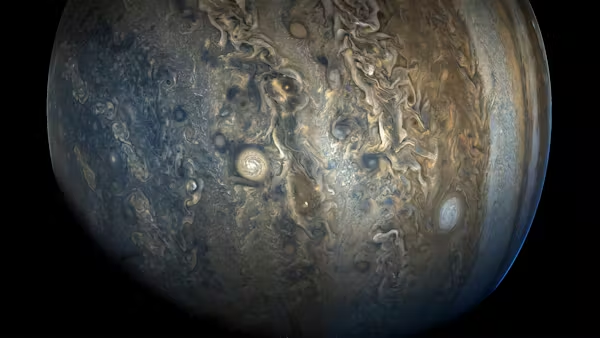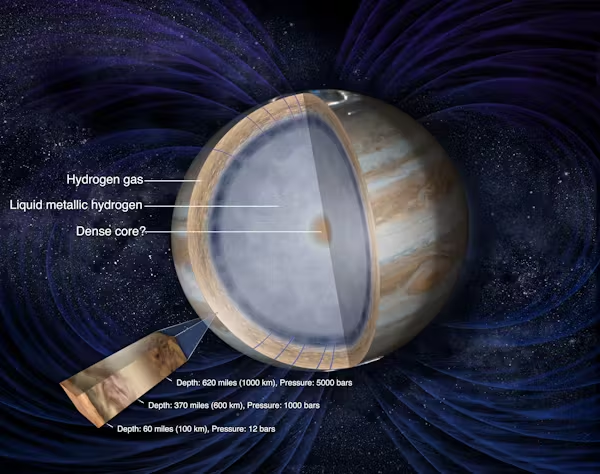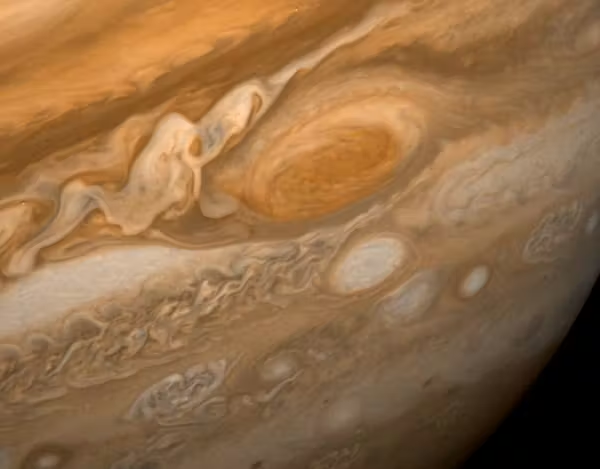Jupiter Has No Surface. Here’s How That’s Possible

The planet Jupiter has no solid ground—no surface, like the grass or dirt we walk on here on Earth. There’s nowhere to land or walk on.
But how is that possible? If Jupiter has no surface, then what does it have? How does it hold together?
Even for a physics professor who studies unusual phenomena, imagining a world without a solid surface is challenging. Much about Jupiter remains a mystery, even as NASA’s robotic probe Juno enters its ninth year orbiting the planet.
Basic Facts About Jupiter
Jupiter, the fifth planet from the Sun, lies between Mars and Saturn. It’s the largest planet in the solar system, big enough to fit over 1,000 Earths with room to spare.
While the four inner planets—Mercury, Venus, Earth, and Mars—are solid and rocky, Jupiter is a gas giant with a composition similar to the Sun. It’s a turbulent, stormy ball of gas, with some regions experiencing winds that exceed 400 mph (640 km/h), about three times faster than a Category 5 hurricane on Earth.

Seeking Solid Ground
On Earth, starting from the top of the atmosphere and descending about 60 miles (100 km), air pressure gradually increases until you reach solid ground, either land or water.
In Jupiter, beginning from the upper layer of its hydrogen and helium atmosphere, the pressure also increases as you go deeper. But on Jupiter, this pressure becomes extreme.
After descending 1,000 miles (1,600 km), the hot, dense gas begins behaving oddly and eventually turns into liquid hydrogen, forming what can be considered the largest “ocean” in the solar system—though it contains no water. Descend another 20,000 miles (32,000 km), and the hydrogen transitions into a state resembling metallic liquid, where electrons move freely. These changes happen gradually, with no clear boundary or solid surface.

The Threatening Core
Continuing deeper, we would eventually reach Jupiter’s core, which, despite being central, should not be confused with a surface.
The exact nature of the core is debated, but the most widely accepted model suggests it’s a hot, dense mixture, possibly metallic. The pressure at Jupiter’s core is equivalent to 100 million Earth atmospheres, and temperatures of 20,000 degrees Celsius (35,000 degrees Fahrenheit) would destroy any spacecraft trying to reach it.

Jupiter’s Protection for Earth
Although hostile to life, Jupiter might have been crucial for life’s existence on Earth. Its strong gravitational pull alters the path of asteroids and comets, preventing many from colliding with the inner planets. Without this protection, Earth might have faced extinction events, like the one that ended the age of dinosaurs.
Hope for Life on Europa
Though Jupiter is inhospitable to life, its moon Europa might be our best chance of finding life within the solar system. NASA’s Europa Clipper probe, set to launch in October 2024, will make around 50 flybys of the moon to explore its vast underground ocean, with hopes of finding signs of life. However, due to Jupiter’s distance, the probe is expected to reach Europa in April 2030.
Raed the original article on: Science Alert
Raed more: Juno Finishes Its Nearest Pass by Jupiter’s Volcanic Moon Io










